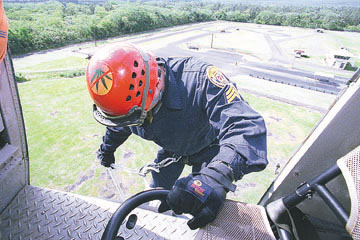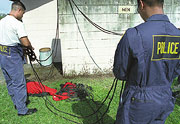"The money that's expended for the eradication program comes from a grant from the federal government. There's some misconception if a citizen thinks that if we don't spend that money for marijuana eradication we can spend it for something else. It's not either/or: Either we pay for marijuana eradication or buy new school buses. The money is dedicated to the State of Hawaii to eradicate marijuana plants. If the State of Hawaii decides it doesn't want to accept the money, it goes to another state." Tom Kelly, assistant special agent in charge of the Drug Enforcement Administration's Honolulu district office
"(Marijuana eradication has) been one of the most successful programs we've ever had. It's gotten our forests back and our wild open spaces so that we don't get threats of violence against the hikers, the maile pickers, the hunters. We couldn't just sit back and do nothing. There's still marijuana being cultivated, but not nearly the volume, and the violence isn't nearly the same. It was nasty." Big Island Police Capt. Dale Fergerstrom, who was part of the original Operation Green Harvest as a foot patrolman and now is a Big Island police captain |
Detective Marshall Kanehailua rappels out of a Hughes 500 helicopter during a marijuana eradication training exercise above the Hilo drag strip. Kanehailua's father was one of the original members of Operation Green Harvest when it began in 1976.
Operation Green Harvest began on the Big Island in 1976 with as many as 75 federal, state and local narcotics officers backed by police and National Guard helicopters. It was so secret that officials didn’t acknowledge it publicly for another two years.
“At the last minute, they would say, ‘You, you, and you — report to a certain area for marijuana eradication.’ They dragged me through the bushes, hiking for miles following a helicopter.” As millions of dollars in federal drug enforcement money began to flow into Hawaii, the war on marijuana spread to Kauai, Maui and Oahu. Eventually it included helicopters from private companies, police, the DEA and National Guard. Personnel came from four island police departments, the DEA, the state Department of Land and Natural Resources, Army, Coast Guard, Postal Service, National Park Service, Bureau of Alcohol, Tobacco and Firearms and the Internal Revenue Service. Operation Green Harvest became Operation Wipeout. Today, it is officially the Counter Cannabis Field Operation, a local version of the federal Domestic Cannabis Eradication/Suppression Program. But the name Green Harvest stuck. Its peak came in the 1980s when authorities routinely pulled more than 1 million plants out of the Big Island each year. In a study released in 1989, Attorney General Warren Price worried that victories over the pakalolo industry would create a vacuum that harder drugs could fill. He said there was evidence that Mainland gangs had moved into Hawaii’s drug industry. And he was bothered by how the war on marijuana was progressing.
Today, Hawaii’s war on marijuana is fought with a fifth of the manpower of the early days, and plant seizures are down to about 300,000 each year. From 1993 through 1997, the four Island police departments and the state Department of Land and Natural Resources received a total of $2.58 million for marijuana eradication from the DEA. Annual allocations ranged from $400,000 to $600,000. But law enforcement officials don’t want the true costs to be known because fighting marijuana generates federal grants, said Donald M. Topping. He’s the former director of the Social Science Research Institute at the University of Hawaii and president of the Drug Policy Forum of Hawaii, which questions the wisdom of American drug policies. Without an overall accounting, Topping said, the people of Hawaii cannot have an informed debate on whether to continue Green Harvest. “Only a fool would say our current policies are having an effect,” Topping said. “Yet we continue to pursue them in the face of overwhelming evidence that they do not work.” The National Organization for the Reform of Marijuana Laws (NORML) has collected audits of anti-marijuana programs around the country for years. None of them makes a comprehensive, year-by-year assessment of whether the programs work, said Allen St. Pierre, NORML’s executive director. In 1997, the DEA stopped publishing annual reports on its anti-marijuana campaign, St. Pierre said. NORML continues to file Freedom of Information Act requests for the data and now receives figures that are nearly unintelligible, he said. “A lot of the information that was publicly disseminated ended,” he said. “It’s not easy to get data anymore.” The Hawaii Army National Guard was one of the few agencies to provide The Advertiser with detailed information about its involvement in the Counter Cannabis Field Operation. The guard flew its Huey helicopters during the first Green Harvest missions and later used its Bell Kiowa OH-58s during the 1990s, according to spokesman Capt. Chuck Anthony. According to its records, though, the Guard began flying missions only in fiscal year 1989, Anthony said. “I know that can’t be right,” Anthony said. “I know we were in on the original Green Harvest.” The picture becomes even cloudier because the National Guard does not separately account for marijuana eradication missions. The cost is somewhere in the $3.6 million the Guard spent in 1999 on drug seizure operations. James White, now a researcher at the UH globalization research center, tried to add up the price of Hawaii’s marijuana war in 1995 for the statewide Substance Abuse Task Force. He filed unsuccessful Freedom of Information Act requests with the Justice Department and had no better luck with state and local authorities. “There were several problems,” White said. “We were lied to quite a lot. The Neighbor Island police forces don’t necessarily cooperate. Even if they did cooperate, there was no consistency in how people broke the figures down. I was amazed that they had different fiscal years. So you were constantly comparing apples and oranges. “I didn’t feel there was a great conspiracy going on,” White said. “I felt it was more incompetence and some minor deceptiveness. On the other hand, fairly substantial funds are being spent, and it’s unknown whether it’s being audited properly at all.”
|
|||||||||||||||||||||||||||||||||||||||||||||||||


 “The only problem with the eradication effort in Hawaii is that it is costing over $1 million per year, and it is not apparently reducing, much less eliminating, the marijuana industry in Hawaii, nor is there any evidence to suggest it is reducing local consumption,” Price wrote. “Despite the years of eradication efforts, the industry has flourished and grown, and widespread consumption continues.”
“The only problem with the eradication effort in Hawaii is that it is costing over $1 million per year, and it is not apparently reducing, much less eliminating, the marijuana industry in Hawaii, nor is there any evidence to suggest it is reducing local consumption,” Price wrote. “Despite the years of eradication efforts, the industry has flourished and grown, and widespread consumption continues.”